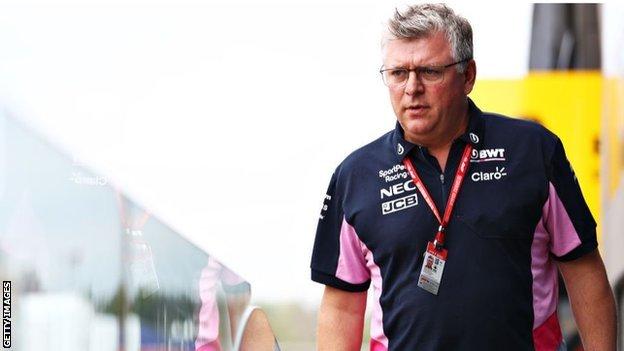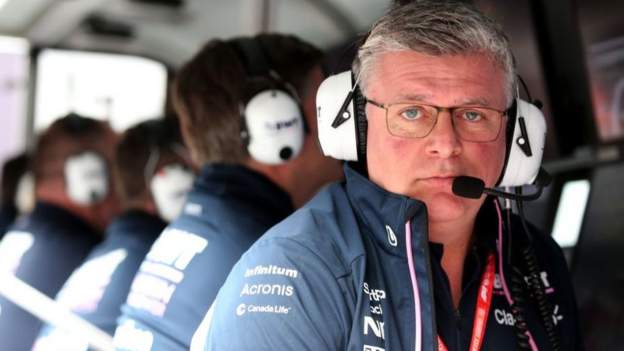
Otmar Szafnauer has joined Alpine as team principal as part of a wider management restructure of the Renault-owned F1 team.
The ex-Aston Martin team boss will bring “technical knowledge and leadership to build the team across multiple areas,” chief executive officer Laurent Rossi says.
It sees Alpine return to a traditional organisation after an unusual three-man senior management team last year.
Rossi said the changes were needed.
He added it would “take the team to the next level”.
Alpine finished fifth in the championship last year, the third consecutive season in that position for the team that used to be called Renault.
Rossi admitted they had only not slumped to sixth because rookie Yuki Tsunoda in the faster Alpha Tauri car was not on the same level as his team-mate Pierre Gasly.
Rossi said this proved Alpine were “plateauing in almost a negative slope” and that changes needed to be made.
He insisted the old management structure was “working fine” but that it was “obvious we needed someone” who could “oversee operations and development” across all three aspects of the team – the chassis base in the UK, the engine factory at Viry-Chatillon near Paris, and trackside at races.
Of the three pillars of Alpine’s 2021 top management, only Rossi remains.
Former executive director Marcin Budkowski left Alpine last month. Davide Brivio, recruited from MotoGP for last season as racing director, has been moved to a new role as director of racing expansion projects, essentially overseeing Alpine’s driver-development programme.
At the same time, Bruno Famin, the former deputy secretary-general for sport at governing body the FIA, has been recruited as executive director of Alpine at Viry-Chatillon, responsible for power-unit development.
These moves follow last month’s restructure of the technical department at their base at Enstone in Oxfordshire in which former chassis design head Pat Fry was promoted to chief technical officer and Matt Harman, formerly engineering director, to technical director.
Rossi said the changes were a result of Alpine’s development as an organisation, following Renault chief executive officer Luca de Meo’s decision last year to rebrand the F1 team after the French car giant’s niche sportscar division and integrate the road-car and racing operations under one leader.
“It takes a bit of time to find the right people in the right places,” said Rossi, who is going into his second year in charge of Alpine.
“The combination of the three of us last year enabled us to never look stupid on track. That’s the most important thing.
“In that respect, it worked. We went through the season. We never made a fool of ourselves. It was just fine. But was it the right structure to take the team to the next level? It was not what was needed for the next challenges.
“I decided we needed to reinforce the team and in so doing go back to a more conventional rigid structure because Otmar has way more experience in F1 than the three of us had last year. He has the pedigree and he has the skills.”
An all-new engine for 2022
Rossi said the changes at Alpine were aimed at bringing the team up to a level where it could compete at the front.
Part of that plan is the decision to design an entirely new engine to power drivers Fernando Alonso and Esteban Ocon this season.
The new power-unit follows the philosophy set by Mercedes at the start of the turbo-hybrid era in 2014, and since followed by Honda. It splits the turbo and compressor, two parts that in a conventional design sit next to each other, by putting the compressor at the front of the engine and the turbo at the back.
“The engine has been redesigned entirely,” Rossi said. “The split turbo is one element. We will [also] make it more compact, which enables us to move it closer to the driver and therefore the centre of gravity of the car.
“It’s lighter. It’s capable of operating in a much wider range of conditions, temperature and pressure.
“So it’s really like a game-changer for us and it’s going to, I hope, enable us to catch up and close the gap to the front of the queue [on engine performance].”
The split-turbo design is difficult to achieve because it requires a long connecting rod between the turbo and compressor that runs across the top of the engine and spins at up to 125,000rpm.
Former Alpine non-executive chairman Alain Prost said when he split with the team last month that the engine was having reliability problems on the test bed.
Rossi said the failures were caused by his asking the engine department to push as hard as possible for maximum performance. He said the design was now running reliably in time for the start of pre-season testing next week.
Rossi said: “I told the team: ‘You push the envelope far. I don’t care. I’d rather have to dial down the performance, but know that I’ve reached a peak of the performance I can get and then be reliable, than just feel comfortable with a reliable engine that was not delivering the performance.’ Which, by the way, was the approach of the past.
“The good news is we’ve been doing thousands of kilometres with this new power-unit in the last few weeks, and it went just fine.
“So knock on wood it seems we have fixed that.”


